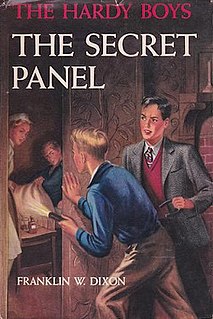
Mildred Augustine Wirt Benson was an American journalist and writer of children's books. She wrote some of the earliest Nancy Drew mysteries and created the detective's adventurous personality. Benson wrote under the Stratemeyer Syndicate pen name, Carolyn Keene, from 1929 to 1947 and contributed to 23 of the first 30 Nancy Drew mysteries, which were bestsellers.
Carolyn Keene is the pseudonym of the authors of the Nancy Drew mystery stories and The Dana Girls mystery stories, both produced by the Stratemeyer Syndicate. In addition, the Keene pen name is credited with the Nancy Drew spin-off, River Heights, and the Nancy Drew Notebooks.
The Stratemeyer Syndicate was a publishing company that produced a number of mystery book series for children, including Nancy Drew, The Hardy Boys, the various Tom Swift series, the Bobbsey Twins, the Rover Boys, and others. They published and contracted the many pseudonymous authors doing the writing of the series from 1899 through 1987, when the syndicate partners sold the company to Simon & Schuster.

The Hardy Boys, brothers Frank and Joe Hardy, are fictional characters who appear in several mystery series for children and teens. The series revolves around teenagers who are amateur sleuths, solving cases that stumped their adult counterparts. The characters were created by American writer Edward Stratemeyer, the founder of book-packaging firm Stratemeyer Syndicate. The books themselves were written by several ghostwriters, most notably Leslie McFarlane, under the collective pseudonym Franklin W. Dixon.

Franklin W. Dixon is the pen name used by a variety of different authors who wrote The Hardy Boys novels for the Stratemeyer Syndicate as well as for the Ted Scott Flying Stories series published by Grosset & Dunlap.

Howard Roger Garis was an American author, best known for a series of books that featured the character of Uncle Wiggily Longears, an engaging elderly rabbit. Many of his books were illustrated by Lansing Campbell. Garis and his wife, Lilian Garis, were possibly the most prolific children's authors of the early 20th century.
Roy Rockwood was a house pseudonym used by Edward Stratemeyer and the Stratemeyer Syndicate for boy's adventure books. The name is most well-remembered for the Bomba the Jungle Boy series.

Edward L. Stratemeyer was an American publisher, writer of children's fiction, and founder of the Stratemeyer Syndicate. He was one of the most prolific writers in the world, producing in excess of 1,300 books himself, selling in excess of 500 million copies. He also created many well-known fictional book series for juveniles, including The Rover Boys, The Bobbsey Twins, Tom Swift, The Hardy Boys, and Nancy Drew series, many of which sold millions of copies and remain in publication. On Stratemeyer's legacy, Fortune wrote: "As oil had its Rockefeller, literature had its Stratemeyer."
Charles Leslie McFarlane was a Canadian journalist, novelist, screenwriter, and filmmaker, who is most famous for ghostwriting many of the early books in the very successful Hardy Boys series, using the pseudonym Franklin W. Dixon.

Victor Appleton was a house pseudonym used by the Stratemeyer Syndicate and its successors, most famous for being associated with the Tom Swift series of books.

The Tower Treasure is the first volume in the original The Hardy Boys Mystery Stories published by Grosset & Dunlap. The book ranks 55th on Publishers Weekly's All-Time Bestselling Children's Book List for the United States, with 2,209,774 copies sold as of 2001. This book is one of the "Original 10", generally considered by historians and critics of children's literature to be the best examples of all the Hardy Boys, and Stratemeyer Syndicate, writing.

The House On The Cliff is the second book in the original The Hardy Boys Mystery Stories published by Grosset & Dunlap. The book ranks 72nd on the Publishers Weekly's All-Time Bestselling Children's Book List in the United States with 1,712,433 copies sold as of 2001. This book is one of the "Original 10" Hardy Boys books and is an excellent example of the writing style used by the Stratemeyer Syndicate's writers. This style influenced many other "youth adventure series" books that the Stratemeyer Syndicate also published, including the Nancy Drew series, the Tom Swift adventure series, the Bobbsey Twins and other lesser known series. All of them used a unique writing style that made them very recognizable as Stratemeyer product.

The Disappearing Floor is Volume 19 in the original The Hardy Boys Mystery Stories published by Grosset & Dunlap.

The Secret Panel is Volume 25 in the original The Hardy Boys Mystery Stories published by Grosset & Dunlap.

The Mystery of the Ivory Charm is the thirteenth volume in the Nancy Drew Mystery Stories series. It was first published in 1936 under the pseudonym Carolyn Keene. The actual author was ghostwriter Mildred Wirt Benson.

Lilian C. Garis , born Lilian C. McNamara was an American author who wrote hundreds of books of juvenile fiction between around 1915 and the early 1940s. Prior to this, she was the first female reporter for the Newark Evening News in New Jersey. Garis and her husband, Howard R. Garis, were possibly the most prolific children's authors of the early 20th century.
The Betty Gordon books were an early Stratemeyer Syndicate series, published under the pseudonym Alice B. Emerson.
The Honey Bunch series of books were part of the Stratemeyer Syndicate's production of 20th century children's books featuring adventurous youngsters, which included the series Nancy Drew, the Hardy Boys and the Bobbsey Twins. This series was written under the pseudonym Helen Louise Thorndyke, and published for most of its duration by Grosset & Dunlap. The series began in 1923 and chronicled a young girl named Honey Bunch on her various trips and adventures. Along with Laura Lee Hope's series Bunny Brown and His Sister Sue, it was one of their most famous series for younger children.
James Duncan Lawrence was an American author, best known for authoring most of the Tom Swift Jr. series of books under the pseudonym Victor Appleton II.











